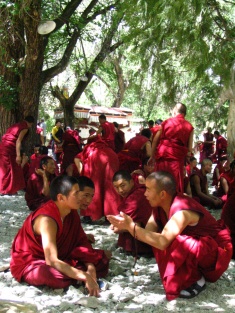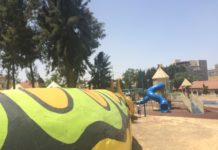It would be the easiest thing in the world to relax, sit back and watch the Beijing Olympics on my porch in Sderot.
Yet, it is hard to forget flashbacks from exactly three years ago, when I traveled through Tibet; an enchanted nation with the highest altitude in the world, which lives under the iron fist of the Beijing government. I was exposed to Tibet for the first time while visiting Nepal, during a three-week trek around the Annapurna
” iexperienced for the first time in my life the meaning of not being free.”
Himalayan mountains, when our guide screened the movie Seven Years in Tibet starring Brad Pit. That film depicted the Chinese oppressive policies in Tibet, including the brutal expulsion of the Dalai Lama and his peaceful Tibetan people to Northern India. When I took a walk outside of that small movie hall I was overwhelmed by the same exact enormous mountain views of the movie – only from the other side. I then decided to travel to Tibet.
The dirt road from Nepal to Tibet, a five-day jeep journey to Lhasa, the Tibetan capital, was packed all the way with laborers; men, women and children, constructing Chinese paved roads in the highest altitudes in the world.
I traveled around Tibet for one month and I experienced for the first time in my life the meaning of not being free; not free as a people, not as a nation, and not being able to worship your own G-d and to hold your own beliefs. The Tibetans are prohibited from possessing any picture, portrait or sculpture of the Dalai Lama, whom they consider to be a divine figure. While stopping at the villages in Tibet on the way to Lhasa, our group, hailing from different parts of the world, gave out small pictures of the Dalai Lama (photocopied from the Lonely Planet guidebook) to the villagers. It is hard to forget witnessing a 70-year-old woman see a photo of the Dalai Lama for the first time in 50 years. We watched her excitement; tears started to flow down her face.
Refusing to pay an expensive entrance fee to the Chinese government, we sneaked into the Potala Palace, the one-time residence of the Dalai Lama. We noticed a Tibetan man and a Tibetan woman doing construction work on the roof, and performing a special ceremony and dance while fixing up a holy place. All the while, a huge Chinese flag waved in the background, just in case they forget who’s in charge.
Monks in Tibet
Passing through the country, we noticed that every single thing you want to do, see or experience – any ritual or Tibetan tradition – is transformed into a fee payable to the Chinese government. For any monastery, any trek or lake, you have to go through a travel agency; and the most expensive tourist attraction is to ride towards the Mount Everest base camp, paying an expensive fee. It seemed like the Chinese turned Tibet into their own amusement park, charging for every single ride.
Walking around Lhasa, we became friendly with some local Tibetans who had come on a six-day walk from different parts of Tibet. We helped a Lama devotee and his delegation to send a fax. We met a Tibetan history teacher who revealed to us that 90% of Tibetan history was destroyed by the Chinese. In Lhasa, he said, they only teach Chinese. “There are only four history teachers left in Tibet,” the teacher explained. We then arrived by accident at the village of Tabo in the Spiti Valley, where I witnessed a Tibetan Festival that occurs once in seven years
“These experiences carried a message of the importance of a homeland.”
All of these experiences carried a message of the importance of a homeland; a place where one can feel free and safe to celebrate traditions and beliefs that have been celebrated for thousands of years.
Sitting in Sderot, writing and remembering these experiences from Tibet and India, I appreciated the fact that we Jews live freely in our own land. I thought also of the past few months and of where I live, a place that has been targeted by more than 600 rockets, missiles and mortars in that short span of time.
Yes, unlike the people in Tibet, we live in an independent homeland. We are free. Yet, where we live, in Sderot, even if we would like to sit back and relax and watch the Olympics, it is hard to relax. We know the reality in Sderot, where our freedom is being challenged.
And it is equally hard to forget the reality of Tibet, where it is impossible for Tibetans to relax, because they cannot sit back and live in freedom
under Chinese rule.
Watch Noam Bedein’s gallery – From Tibet to Sderot












